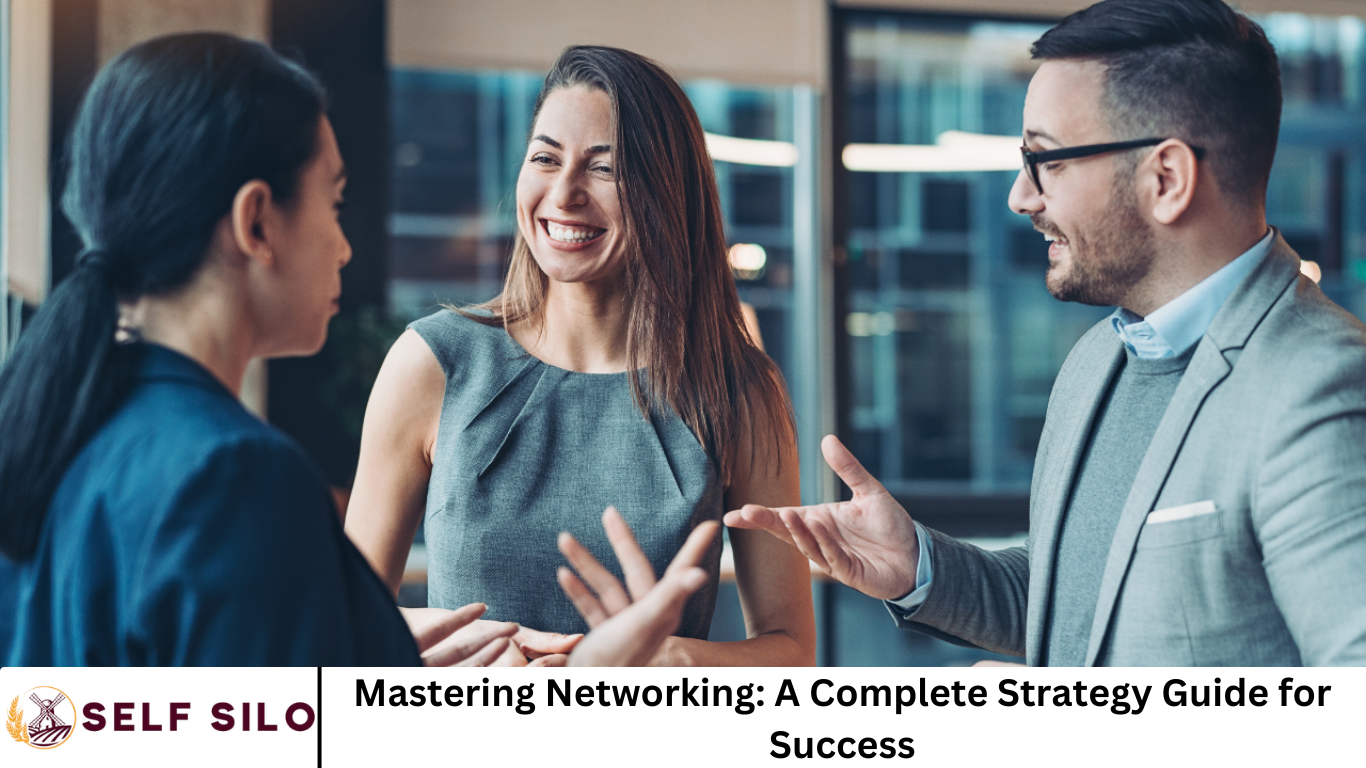Interconnected world, networking is not just a skill—it’s a strategic asset. Whether you’re climbing the corporate ladder, launching a business, or exploring new career opportunities, your ability to build and maintain meaningful relationships can define your success.
This complete strategy guide will walk you through everything you need to master networking—from mindset and preparation to in-person and online tactics—so you can turn connections into lasting value.
More Read: Say It Right: 7 Proven Tips to Boost Your Presentation Game
Why Networking Matters in 2025 and Beyond
Networking is more than exchanging business cards or growing your LinkedIn connections. It’s about creating genuine relationships that offer mutual value. According to research from LinkedIn, 85% of jobs are filled through networking, and professional success is often tied to who you know, not just what you know.
Strong networks help with:
- Career advancement and job opportunities
- Business development and partnerships
- Learning and mentorship
- Access to exclusive industry insights
- Personal growth and confidence
1. Shift Your Mindset: Networking Is About Giving, Not Just Getting
To build meaningful connections, approach networking with a value-first mindset. Ask yourself:
- How can I help this person?
- What knowledge, resources, or introductions can I offer?
When you give without expecting immediate returns, people remember you. Over time, your generosity builds trust and goodwill—two vital components of a sustainable networking strategy.
2. Define Your Networking Goals
Like any strategy, successful networking starts with clear goals. Ask yourself:
- Are you looking for a new job?
- Do you want to grow your business?
- Are you seeking mentors or collaborators?
- Do you want to build your personal brand?
Once you know your objectives, you can tailor your approach and target the right people and platforms.
3. Identify and Categorize Your Network
Start by mapping out your current network. Use these categories:
Inner Circle
Close contacts like mentors, friends, colleagues—people who know you well and are willing to vouch for you.
Professional Connections
Peers in your industry, former coworkers, managers, clients, and partners.
Aspirational Contacts
Influencers, executives, or thought leaders you admire and want to connect with.
Use a CRM tool, spreadsheet, or LinkedIn tags to organize your contacts. Keep notes on your last interaction and how you can add value.
4. Build a Personal Brand That Attracts Connections
In today’s digital-first world, your online presence is your business card. Before reaching out, optimize your profiles—especially on LinkedIn.
Tips for a Strong LinkedIn Profile:
- Use a professional photo and compelling headline
- Write a clear, benefit-driven summary
- Highlight key accomplishments and endorsements
- Post insights and engage with others’ content regularly
A polished profile signals credibility and attracts inbound opportunities.
5. Master the Art of the Introduction
When reaching out to new contacts, your approach matters. Here’s a simple formula for a cold or warm introduction:
Subject Line: Quick Intro + Shared Interest/Context
Message Body:
- Who you are
- Why you’re reaching out
- What you admire about them or how you can add value
- A clear ask (coffee chat, 15-min call, mutual intro)
Example:
Hi [Name],
I’ve been following your work on [topic] and really admire your insights. As a fellow [industry] professional exploring similar challenges, I’d love to connect and learn from your experience. Would you be open to a quick 15-minute call next week?
Best,
[Your Name]
Keep it concise, relevant, and respectful of their time.
6. Attend Networking Events with Intention
Conferences, trade shows, meetups, and industry events are goldmines for building in-person relationships. But to make them work, you need a plan.
Before the Event:
- Set goals (e.g., meet 5 new people)
- Research attendees and speakers
- Prepare your elevator pitch
During the Event:
- Be approachable and ask open-ended questions
- Avoid selling—focus on listening and sharing stories
- Take notes after each conversation
After the Event:
- Follow up within 48 hours
- Send a personalized message referencing your chat
- Add them to your LinkedIn or contact system
Consistency in follow-up is key to turning casual encounters into lasting relationships.
7. Leverage Digital Networking Platforms
Virtual networking is not just a pandemic-era solution—it’s here to stay. Platforms like LinkedIn, Twitter, Slack communities, and niche forums allow you to connect across geographies and industries.
Effective Digital Networking Tips:
- Engage regularly with insightful comments
- Share helpful resources or your own content
- Join online groups or mastermind sessions
- Use direct messages for personalized outreach
Pro Tip: Be human, not robotic. Authentic engagement trumps automation every time.
8. Offer Value Before Asking for Help
One of the most common networking mistakes is asking too soon. Before making an ask, look for ways to contribute:
- Share an article they’d find interesting
- Introduce them to someone they’d benefit from knowing
- Give feedback on something they’ve posted
- Offer your expertise or time if relevant
Small gestures build relational capital and make your eventual asks more welcome.
9. Follow Up and Nurture Your Relationships
A successful network isn’t built overnight—it’s nurtured over time. Stay in touch through:
- Occasional check-in emails
- Congratulating them on milestones
- Sending thoughtful content or updates
- Meeting up once or twice a year, if possible
Set reminders to reconnect every few months. Use tools like Google Contacts, Notion, or CRM software to stay organized.
10. Learn from Masters of Networking
Some of the most effective networkers are lifelong learners. Read books like:
- “Never Eat Alone” by Keith Ferrazzi
- “How to Win Friends and Influence People” by Dale Carnegie
- “Give and Take” by Adam Grant
Watch TED Talks, follow networking influencers, and reflect on what’s working or not in your own efforts.
11. Avoid Common Networking Mistakes
❌ Being transactional
People can sense when you’re only in it for yourself.
❌ Not doing your homework
Reaching out without context makes you forgettable.
❌ Ghosting your network
Inconsistency leads to lost momentum and trust.
❌ Spamming connections
Quality beats quantity—always.
12. Create a Personal Networking Plan
Put everything together in a structured plan:
| Step | Action |
|---|---|
| Define goals | What do you want to achieve? |
| List key targets | Who should you connect with? |
| Choose platforms | LinkedIn, events, forums, etc. |
| Set a weekly schedule | 3 new connections, 2 follow-ups, 1 event |
| Track interactions | Use a CRM or spreadsheet |
| Review monthly | What’s working? What needs adjusting? |
Consistency is the secret weapon of great networkers.
Frequently Asked Question
What is networking, and why is it important for career success?
Networking is the process of building and nurturing professional relationships that can provide mutual value. It’s important because it opens doors to job opportunities, business partnerships, mentorship, and industry insights—often faster and more effectively than traditional methods.
How do I start networking if I have no connections?
Begin by reaching out to people you already know—friends, family, former classmates, or colleagues. Then, expand by attending events, joining industry groups, and connecting with professionals on platforms like LinkedIn. Start with simple, genuine outreach focused on learning, not asking.
What are the best platforms for professional networking?
- LinkedIn – Ideal for career and business networking
- Slack Communities – Great for niche industries
- Twitter/X – Useful for thought leadership and engaging with experts
- Meetup & Eventbrite – For finding local and virtual networking events
- Clubhouse or podcasts – For real-time conversations and exposure
How can I network effectively without being too self-promotional?
Focus on asking questions, listening actively, and offering value. Share helpful resources, congratulate others on achievements, and build rapport before pitching yourself or your services. Let your knowledge and helpfulness speak for you.
How often should I follow up with my network?
Aim to reconnect with key contacts every 3–6 months, or whenever you have something relevant to share (e.g., a helpful article, an event, or a mutual interest). Timely follow-ups after initial meetings or introductions are especially important—ideally within 24–48 hours.
What’s the difference between online and in-person networking?
Online networking offers convenience, global reach, and scalability. In-person networking allows for deeper, more memorable impressions. The most successful networkers blend both—using digital tools to stay in touch and in-person events to deepen relationships.
What are some common mistakes to avoid when networking?
- Being overly transactional or salesy
- Failing to research your contacts beforehand
- Not following up after initial meetings
- Only reaching out when you need something
- Trying to network with everyone instead of focusing on strategic connections
Conclusion
Mastering networking is not about collecting contacts—it’s about building meaningful, value-driven relationships that evolve over time. Whether you’re looking to advance your career, grow a business, or simply learn from others, a strong networking strategy is one of the most powerful tools you can develop. By shifting your mindset, setting clear goals, leveraging both in-person and digital platforms, and consistently nurturing your relationships, you’ll create a network that not only supports your growth but also opens doors you didn’t even know existed.


